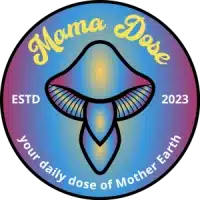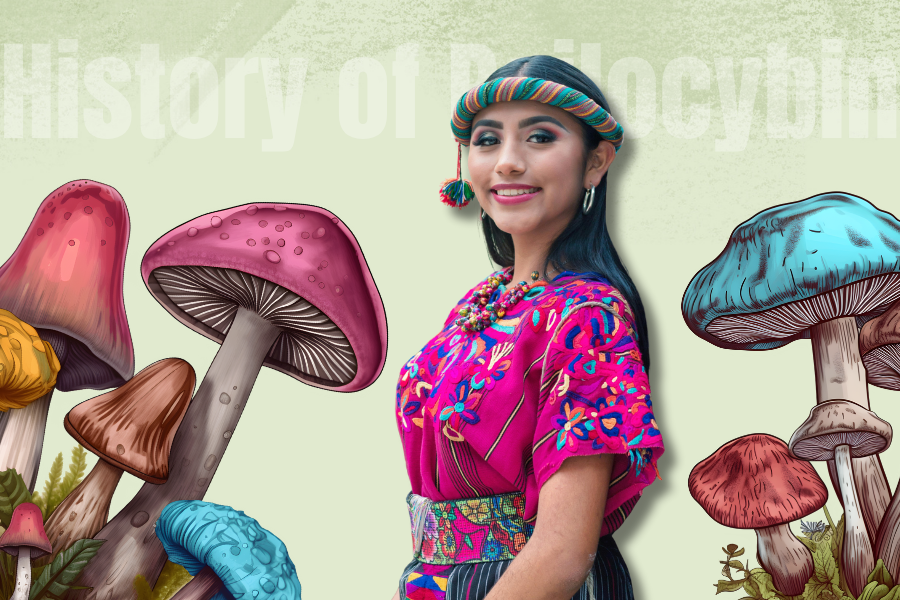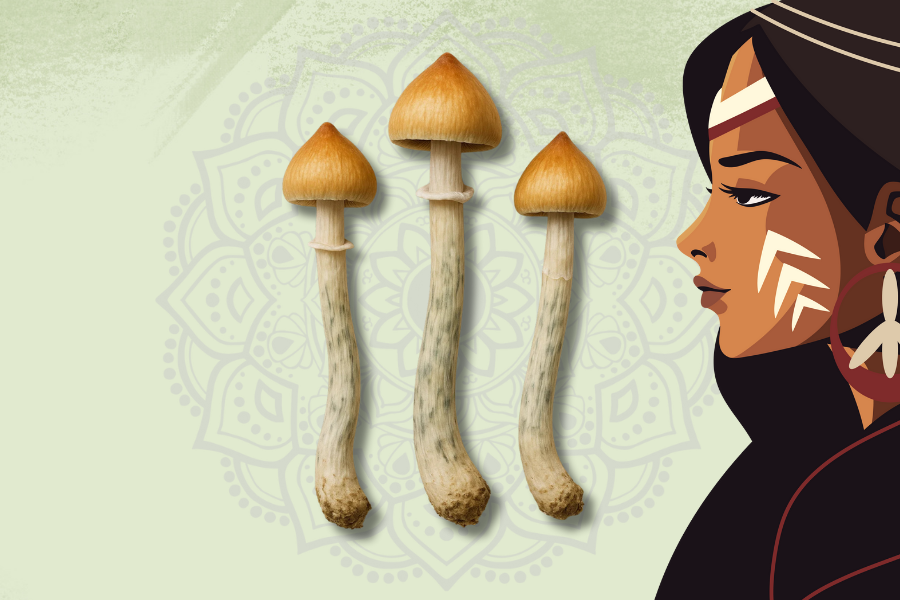

Table of Contents
Toggle
The first time someone tries to explain the “history” of psilocybin, they almost always start with the chemistry. Psilocybin, psilocin, serotonin receptors, all that. But the truth is, long before anyone could name a receptor or sketch a molecular structure, humans were already kneeling in the dirt, holding small brown mushrooms in their palms like they were tiny messengers from somewhere just out of sight. That’s the story that actually matters, the part that stretches across continents and generations and weathered hands. And honestly, it’s wild how much of that story has been sitting right in front of us, hidden in plain view on stones, murals, oral histories, codices, and the quiet persistence of Indigenous ritual.
But let’s start at the beginning, or at least the closest thing to one.
Trying to pinpoint the first use of psilocybin among Indigenous cultures is like trying to find the beginning of a river. You can follow it upstream, but eventually it breaks into smaller streams, then rivulets, then drops of water you can’t separate from the soil.
Some archaeologists look to the rock art of Tassili n’Ajjer in Algeria, where ancient figures appear to dance with mushrooms in their hands. The images are thousands of years old. Whether they truly depict entheogenic fungi remains debated, but the possibility alone creates a spark of recognition. Could humans really have been engaging with psilocybin nine millennia ago? The question lingers like a drumbeat.
In Spain’s Selva Pascuala cave, murals show mushroom-like shapes clustered around a central bull. Again, scholars debate. Were Paleolithic Europeans working with the same fungal allies as Mesoamerican cultures? Or do the shapes simply resemble mushrooms to the modern eye? These questions don’t diminish the intrigue. Instead, they deepen the sense that psilocybin’s human history runs far deeper than many assume.
Still, nowhere on Earth is the relationship between humans and psilocybin more deeply rooted than in Mesoamerica.
Among the Nahua, psilocybin mushrooms carry a name with gravity: teonanácatl, often translated as “flesh of the gods.” The phrase reflects reverence, not metaphor. Within these cultures, the fungi were not substances but beings, entities with agency, wisdom, and specific roles in communal life.
The Mixtec, Mazatec, Zapotec, and other Indigenous peoples of Oaxaca maintain ancient relationships with these mushrooms. Their rituals are not recreational experiences but carefully held spaces filled with prayer, song, intention, and cosmology. The velada, for example, is more than a ceremony; it is an encounter with spirit, a moment where the boundary between worlds thins and communication becomes possible.
Outsiders often describe these ceremonies as “visions,” but for the cultures that continue them, the mushrooms serve as tools of diagnosis, healing, divination, mourning, and celebration. They help guide community decisions. They illuminate hidden truths. They stitch together spiritual, ecological, and social understandings.
Mesoamerica preserved its own archives of mushroom history in the form of pictorial manuscripts known as codices. These texts, precolonial and richly symbolic, offer windows into an older cosmology where mushrooms appear not as props but as characters in divine narratives.
One of the most compelling examples appears in the Codex Vindobonensis, a Mixtec manuscript. In one plate, deities carry mushrooms in their headdresses. A wind god bears a goddess adorned with mushrooms. A rain and lightning god, masked in turquoise and fanged like a serpent, appears before a stalk of maize. Lightning, serpents, rain, maize, and mushrooms form a constellation of meaning: fertility, nourishment, revelation, and the unpredictable generosity of nature.
Some beliefs say the most potent mushrooms grow where lightning strikes, an elegant blend of ecology and myth. Lightning cracks the earth. Mushrooms rise from the wound. Humans ingest them and commune with forces larger than themselves. Everything becomes part of the same cycle, alive and aware.
The codices read like a conversation with the sacred. Modern readers often approach them as artifacts, but within their lines pulse the memories of rituals that shaped entire cosmologies.

Indigenous mushroom use was never singular. Ritual, healing, divination, social cohesion, and celebration all lived within these practices. In some Nahua ceremonies described in early colonial texts, merchants consumed mushrooms with honey, danced throughout the night, and shared visions at dawn. Their experiences were not treated as private hallucinations but as communal knowledge.
Integration existed long before the modern psychedelic movement coined the term. After rituals, participants gathered to compare visions, interpret meanings, and identify lessons for the community. The experience did not end when the effects faded; the wisdom unfolded in conversation, decision-making, and reflection. This relational approach challenges the individualistic framing often seen in modern psychedelic culture. In Indigenous contexts, the mushroom’s power is not isolated within a single person’s mind.
Psilocybin mushrooms play roles in Mesoamerican cosmology that blur the lines between ecology and metaphysics. Rain gods, lightning spirits, maize deities, and mushrooms form a network of reciprocal relationships. Mushrooms are not consumed for escape but engaged for knowledge. They are portals, messengers, and translators.
Lightning strikes the earth, altering the soil, and mushrooms appear. This sequence is not random in these traditions, but sacred. Mushrooms become physical manifestations of divine energy. Their growth mirrors transformation, death, rebirth, and the invisible exchanges happening constantly beneath the soil. Mycelium itself offers a metaphor for Indigenous understandings of the world: unseen connections that nourish, inform, and sustain. Modern science, with its fascination for interconnected fungal networks, is only now catching up to what many cultures already knew intuitively.
The arrival of Spanish colonizers brought violent rupture. Mushroom ceremonies were labeled heretical or demonic. Rituals were banned. Knowledge keepers were persecuted. Much of the tradition retreated underground, surviving through whispered lineages, protected practices, and resistance woven into daily life.
Many codices were destroyed. Oral histories were suppressed. Yet the ceremonies endured. Not because they were trendy or lucrative, but because they remained essential to spiritual health, community identity, and healing.
When María Sabina’s veladas later caught the attention of outsiders in the 1950s, global interest in psilocybin exploded. But Sabina herself emphasized that the mushrooms were not entertainment. They were teachers, and those who sought them without respect risked misunderstanding or misusing their power.
Her lineage was not an anomaly but part of a much wider tapestry of Indigenous mushroom traditions that never disappeared, even under centuries of pressure.
Today’s psychedelic renaissance often centers around neuroscience, mental health, and clinical applications. These developments hold tremendous promise. But the modern rediscovery of psilocybin did not spring from a vacuum. It emerged through an ancient doorway carved open by Indigenous knowledge, sacrifice, and continuity. Every decriminalization campaign, every retreat center, every clinical trial traces back to cultures that treated these mushrooms with reverence, caution, and relational ethics long before modern researchers showed up.
This raises an important question:
If the contemporary world is benefiting from psilocybin, how will it honor the cultures that preserved these traditions?
Ethical engagement requires more than acknowledgment. It requires reciprocity. It asks modern practitioners to reflect, slow down, and listen to the deeper lineage behind the mushroom’s glow.
History seldom moves in straight lines. It spirals, like a vine or a strand of mycelium. The story of psilocybin in Indigenous cultures is not a relic of the past but a living root system feeding the present. Understanding that lineage deepens the modern relationship with psilocybin, shifting it from a tool of self-improvement to a doorway into something older, wiser, and more communal. The mushrooms themselves seem to echo this. They rise after storms, burst through decay, and offer humans a chance to see the world with new eyes. Indigenous cultures recognized that long ago and built entire cosmologies around the lessons these fungi imparted.
Can modern society cultivate the same humility, reciprocity, and respect? Perhaps the answer lies underground, in the unseen network that connects everything. Or perhaps it lies in the next mushroom that appears after rain, reminding the world that wisdom often arrives quietly, wearing a simple brown cap and carrying a message older than history itself.
Invite your friends and earn a discount on your next purchase. Your friend also earns a discount! Get started now, by sharing your referral link with your friends.
This item is currently out of stock!
By adding it to your cart, you confirm a backorder purchase, and we will ship it as soon as it becomes available.